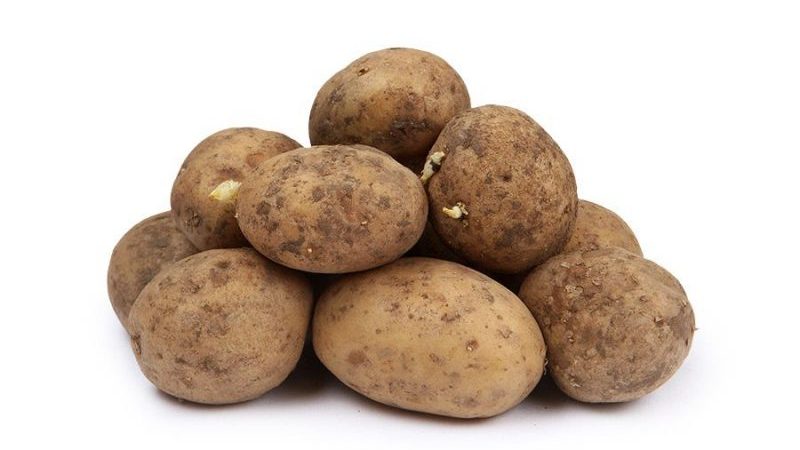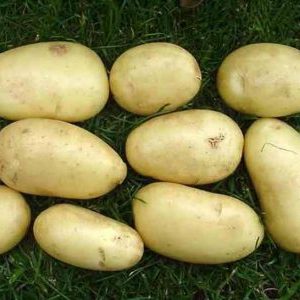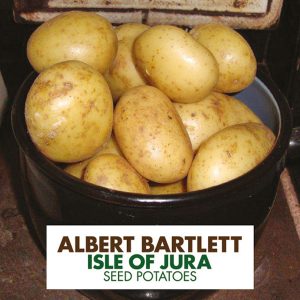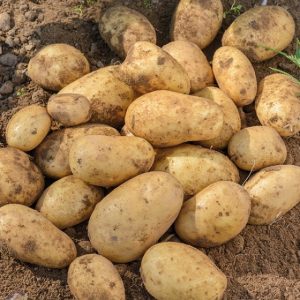Medium early table potato variety "Isle of Jura"
Isle Of Jura potatoes are an English-Russian variety that is increasingly chosen by domestic vegetable growers. It has gained increased demand due to its resistance to short-term frosts, unpretentious care, excellent keeping quality of tubers and their universal use.
The article will tell you what features and advantages this variety has, what are the rules of its agricultural technology and whether there may be difficulties in growing.
The content of the article
Description of the variety
Isle of Jura potatoes are table varieties. Its tubers are neat and tasty. Excellent for all types of heat treatment - cooking, frying, stewing, baking. The variety appeared on the island of Jura, which is located near Scotland. But first things first.
Origin and development
Breeders from Russia and Great Britain decided to develop a new potato variety that could satisfy the needs of vegetable growers in both countries. Thanks to joint efforts and hard work, the farmers were able to get to know the Isle of Jura. The variety has a different name - Dzhura potatoes, grown in the Central region and northern regions of Russia, Ukraine and Moldova.
The variety was included in the State Register of the Russian Federation of Breeding Achievements in 2007. For more than 10 years, Dzhura has not lost its position in the market and is one of the five best Russian potato varieties.

Chemical composition, trace elements and vitamins
Potato tubers contain many nutrients. They are as follows:
- proteins and carbohydrates (starch from 12 to 16%, fiber, pectin substances, glucose, fructose, sucrose);
- B vitamins (B1, B2, B5, B6);
- mineral salts (potassium, phosphorus);
- organic acids (citric, oxalic, malic);
- trace elements (iron, zinc, iodine, copper, manganese, fluorine, and so on).
Due to its rich composition, Jura has a beneficial effect on the work of the gastrointestinal tract, the condition of the skin and other organs.
Attention! Like any other potato variety, Jura is not recommended for people suffering from diabetes mellitus, metabolic disorders.
Characteristics of tubers, description of appearance and yield
Jura potatoes have tubers with an oval, slightly elongated shape. Small eyes are sparsely located. The peel is smooth, yellow-beige, thin, easily peeled off, and noticeably coarse during long-term storage.
The pulp is creamy yellow, after heat treatment it becomes soft and crumbly. Taste qualities are high: tasters gave the variety a taste rating of 4 to 5 points.
The weight of one tuber varies within 110-180 g. But there were also large specimens, the weight of which exceeded 200 g. One bush gives from 8 to 11 potatoes of the same size.
The appearance of the plant is characterized by the following features:
- the bush is semi-upright, powerful and spreading;
- reaches a height of 40-60 cm;
- plant type - intermediate;
- leaves are large, slightly wavy, dark emerald color.
The variety can be proud of its decent yield.From 1 hectare a vegetable grower receives from 250 to 350 centners. The commercial quality of tubers is high - 90%.
For which regions is it suitable
Jura potatoes are frost-tolerant and yield high yields even at temperatures around 0 ° C during development. Wind and humid air do not prevent it from growing at full strength. But dry and hot weather, hot summer slow down the development of tubers and even lead to their death.
The variety is suitable for growing in the middle lane and more northern regions of Russia.
Important! If you follow the rules of agricultural technology, Jura will show a high yield in any region. Quite good results were noted in the Volgograd and Astrakhan regions.
What is the difference from other varieties

Jura potatoes differ from other varieties by the table purpose of their tubers. They are of the culinary sun type. This means that the tubers:
- universal;
- moderately mealy;
- the pulp is well boiled.
Another significant difference is the high beta-carotene content. It was this substance that gave the tubers a creamy yellowish and juicy pulp.
The main advantages and disadvantages of the variety
Isle of Jura potatoes proved to be high yielding and hardy in adverse conditions. Tubers develop rapidly, acquire the correct shape and gain weight. Potatoes belong to medium early varieties - they begin to dig them 65-80 days after the first sunrises appear.
Gardeners highlight the following advantages of this variety:
- excellent keeping quality;
- universality of application;
- pleasant and rich taste;
- unpretentiousness in care and weather conditions;
- resistance to many diseases, in particular golden nematode, late blight, cancer;
- early harvest;
- presentation of tubers.
Jura has no serious flaws. There is a relative disadvantage - the inability to develop normally in a too dry summer.
Features of planting and growing
Potatoes do not require special care, long preparatory work for fertilizing the soil, but it is recommended to take some measures.
Preparing for landing
It is important to select the correct area before planting potatoes. A sunny area is preferable (the lowland will not work), on which perennial grasses, winter crops, legumes or flax previously grew. In autumn, dig up the ground well, remove plant roots, add organic matter.
Spring preparation before landing potatoes includes the following activities:
- In April, the planting material is placed in a bright place with a temperature of + 12 ° C so that the tubers form healthy, strong shoots. If the potatoes are large, it is recommended to cut them in half.
- In May, before planting, they dig up the earth, remove the roots of plants, bring in peat and sand.
- Seeds are treated with manganese or garlic infusion to prevent fungal diseases and protect tubers from pests.
- Treatment in "Epin" is recommended - the procedure stimulates the subsequent growth of the bush.
Attention! For an excellent potato crop, heed the advice of experienced farmers. For example, before plowing, add 8 kg of humus or manure, 30 g of superphosphate for each square meter of the plot. Place 130-180 g of wood ash in each well.
Timing, scheme and landing rules
The tubers are planted in mid or late May. The soil temperature will help to determine the exact timing: at the depth of the potato placement, the earth should warm up to + 12 ° C.
When planting, the distance between the holes is 40-50 cm, between the rows - 50-60 cm. The depth of the pits depends on the type of soil:
- structured loam and sandy loam - 8-10 cm;
- heavy clayey - 5-6 cm.
The location of the sprouts during planting does not affect the subsequent yield of potatoes.
Growing features
Potatoes require timely measures for loosening and weeding. They loosen after each watering, do it with light tools so as not to damage the tubers. Weeds are removed and destroyed.
Hilling creates a favorable environment for tubers to gain weight.The procedure is carried out after watering, forming ridges around the bushes with a height of 3-5 cm.
Important! For better development of the plant, before the first hilling, fertilize with a urea solution (dilute 20 g in 10 liters of water). 500 ml of solution is added under the root of each bush.
The nuances of care
It is not difficult to take care of Dzhura if you follow the watering regime, regularly apply top dressing, remove pests and treat bushes from diseases.
Watering mode
According to the creators, the variety loves moisture. The rules are as follows:
- The first time it is watered when the height of the bush is 13-15 cm. Pour 3.5 liters of water under each root.
- The second is when the buds are formed. Pour 6-7 liters of water under each bush.
- The third is during the period of fruit ripening. Increase the volume of water to 12 liters.
Be sure to monitor soil moisture while watering. If the soil is damp, it is not recommended to water the plants - this is fraught with rotting tubers.
Top dressing
Organic fertilizers in the form of manure and humus directly affect yield indicators. But they may not be enough. Additionally, it is recommended to apply complex mineral and organomineral fertilizers. These include: "AVA", "Kemira", "Kristalon", "OMU", "Bulba" and others.
Foliar dressing will improve the overall condition of the stems and leaves. The following mixtures are prepared for processing:
- 90-110 g of urea is diluted in 10 liters of water;
- 150 g of potassium monophosphate is diluted in 10 liters of water;
- 5 g of boric acid is diluted in 10 l of water.
Important! Spray the bushes with a spray bottle with any of the above compositions. The first foliar dressing is necessary after the first watering, and the second after 2-3 weeks. It is recommended to reduce the concentration of drugs by half.
Disease and pest control
Dzhura variety is resistant to potato crayfish, common scab, black leg, golden nematode. But at high humidity, tubers are often affected by late blight. Sick bushes are dug up and destroyed. Healthy people are sprayed with fungicides "Oxyhom", "Ridomil" strictly according to the instructions.
Of the pests, the wireworm, scoop, whitefly, and Colorado beetles usually attack potatoes. Insect control methods are as follows:
- timely remove weeds around plants;
- use modern preparations in the form of insecticides, not forgetting about the instructions;
- collect Colorado potato beetle larvae and adults by hand, spray the stems and leaves with special preparations.
Any variety of potatoes is attacked by Colorado beetles. Jura is no exception. Only timely treatments will help preserve bushes and fruits.
Reference. Experienced farmers noted the best means for potatoes in the fight against pests and diseases. For example, Imidiacloprid and Pencicuron have proven themselves well. They are safe for young sunrises, mature plants and fruits.
Harvesting and storage
Harvesting is a pleasant moment for every gardener. If all the features for the care and cultivation of the variety have been taken into account, then the beds will delight you with mouth-watering and beautiful potatoes.
How and when to collect
Potato harvesting begins in late July or early August. Signs of tubers ripening are dry tops that have fallen to the ground. Better to dig on a sunny day. The dug up tubers are dried within a day or two.
Attention! After harvesting potatoes, it is necessary to destroy the dry tops. Otherwise, it will become an ideal breeding ground for viruses and bacteria.
Storage features and keeping quality of the variety

Sort the collected potatoes thoroughly. Remove rotten and damaged tubers. Arrange the seed material in bags. Pour vegetables into wooden boxes and place them in a cellar, the temperature of which does not exceed + 5 ° C.
The keeping quality of potatoes of the variety in question is considered excellent.... Tubers retain their freshness, firmness and taste for 6-12 months or more. After a long storage period, the fruits do not lose their presentation.
What can be the difficulties in growing
Growing Isle of Jura potatoes is easy and simple. It does not require professional skills and special knowledge from a vegetable grower.
The only difficulty that may arise is infection with late blight. However, this will not happen if the plantings are pre-treated with fungicides.
Tips from experienced gardeners and reviews about the Isle of Jura variety
Experienced gardeners recommend timely removal of weeds, hilling plants, applying top dressing, and getting rid of the Colorado potato beetle. Pay special attention to bushes during the flowering period. It is at this stage that the potatoes need feeding and watering.
Reviews of the Jura variety are only positive.
Alexey, Yasnogorsk: «I decided to try to plant Isle of Jura potatoes. Two weeks ago I dug up large and fleshy tubers. The general impression of the development of the bushes and the taste of the cooked potatoes is positive. I was pleased with the resistance of the variety to adverse weather conditions and diseases. "
Natalia, Dyatkovo: “I have been growing Dzhura potatoes for more than two years. We are pleased with the stable yield. One bush gives 1.5 kg of large, neat potatoes. This result was obtained after adding wood ash to the holes. I recommend everyone to try to grow this variety. "
Read also:
Viable potato variety Blueness.
Conclusion
As you can see, Isle of Jura potatoes are characterized only on the positive side. It is unpretentious in care, does not require special conditions for growth, but at the same time it shows a decent yield.
The variety takes root well in any region of Russia, even in adverse weather conditions. It is enough to take into account all the recommendations and tips to get tasty and healthy tubers.